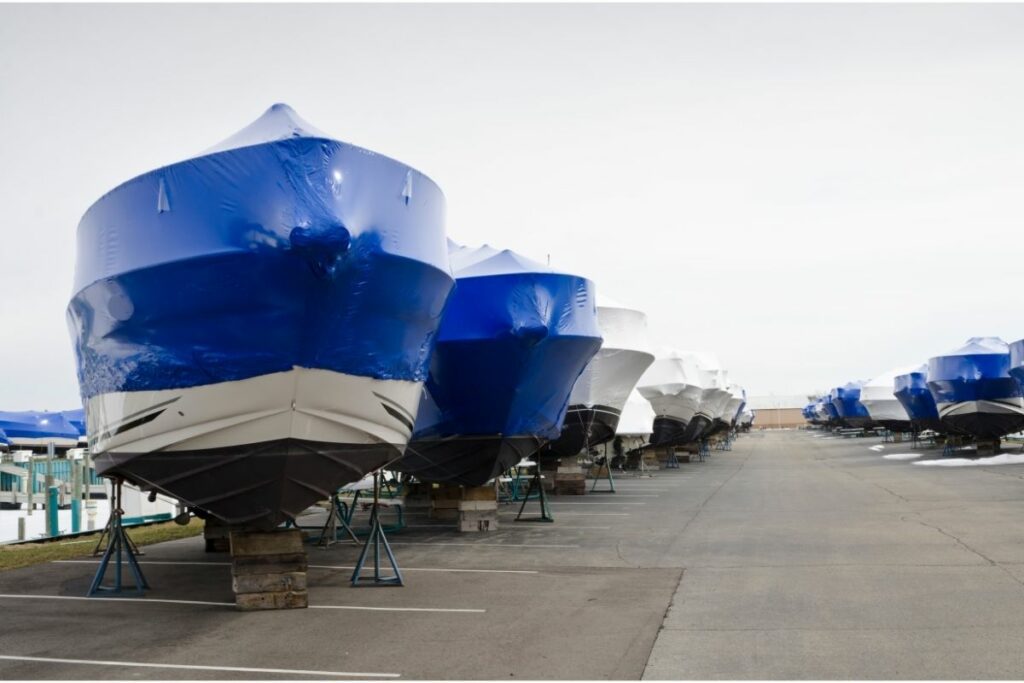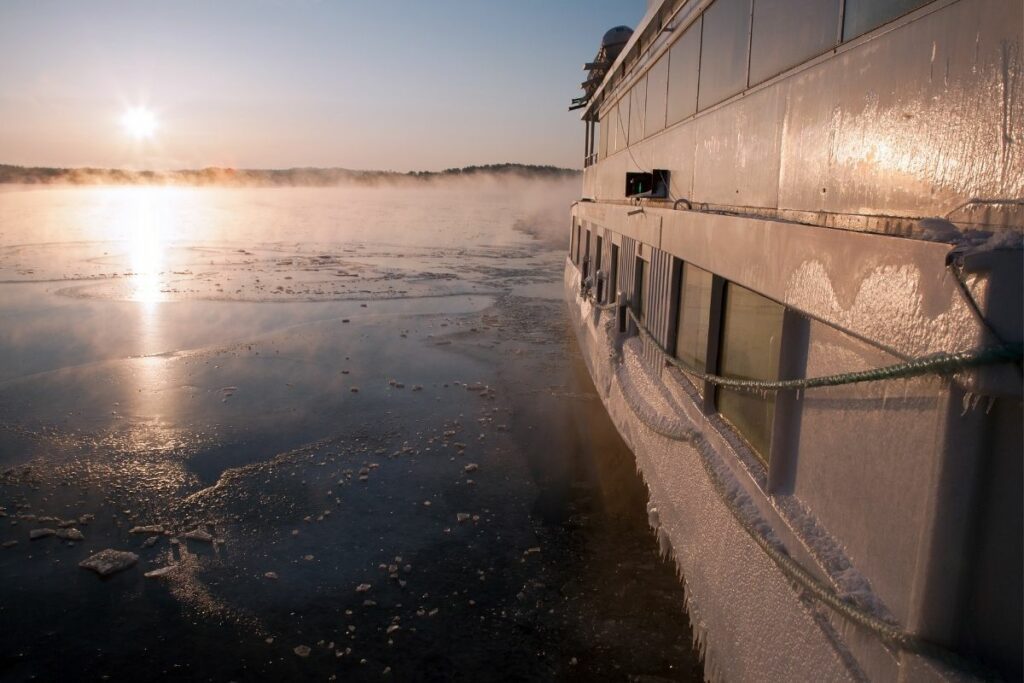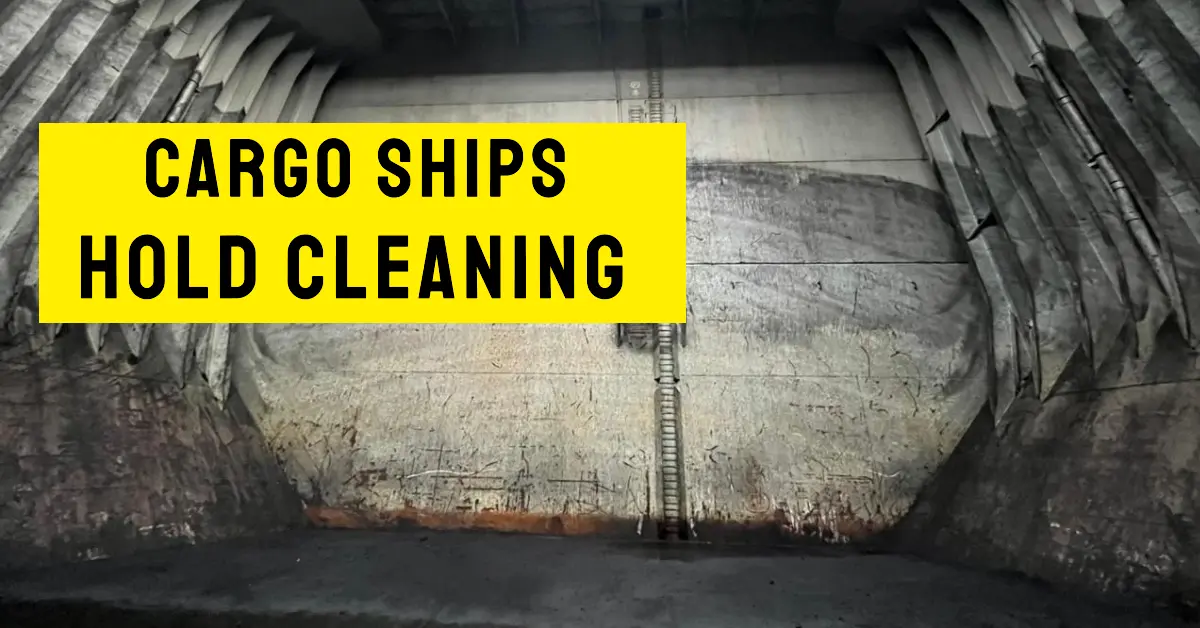How would you react if someone asked you to winterize a boat? Would you panic or simply shrug off the request? Well, if you want to get into boating, then you should know exactly what you’re getting into.

Winterization of a boat is a very important step before you start using it during the cold months.
Winterization of a boat means cleaning out its interior and exterior parts, checking the hull for leaks, and ensuring that the boat has enough fuel and water.
If you don’t winterize your boat properly, you could face serious problems such as flooding, engine failure, or even sinking.
Winterizing a boat is essential because it helps prevent damage from freezing temperatures.
The steps involved in winterizing a boat include removing the gas tank cover, draining the fuel, filling the tank with fresh fuel, adding antifreeze, and topping off the tanks with water.
Before we begin, it’s important to note that there are different ways of winterizing a boat.
Some people use the term to refer to the process of cleaning all the vessel’s components while others only use the word when referring to the process of filling the vessel’s tanks with fresh fuel.
With this in mind, let’s discuss what you need to do in order to winterize a boat properly.
1. Remove The Gas Tank Cover
If you plan on winterizing a boat, you first have to remove the gas tank cover. You can find these covers at any auto parts store.
They usually cost around $10-$20. In addition to being used to block the entrance of potential moisture, they also help keep windblown sand away from the gas tank.
When you remove them, be sure to place them inside so that they do not get damaged by snow or ice.
2. Drain Fuel From The Tanks
After you remove the gas tank cover, drain the fuel from each tank. It’s best to pump the fuel out slowly and stop once the level reaches about halfway down the tank.
Make sure that you leave some space between the bottom of the tank and the ground so that you won’t end up spilling the fuel. Once you finish draining the fuel, make sure that the gas cap remains closed.
3. Fill Up On Fresh Fuel
Next, fill the tanks with fresh fuel. Use a funnel and pour the fuel into the top of the tank until the level reaches the brim. Make sure that the fuel cap is still closed while doing this.
After you complete filling the tanks, turn off the pump and close the valve.
4. Add Antifreeze
After you add fuel to the boat, you need to add an antifreeze additive to help protect against corrosion. For boats that remain indoors year-round, you may be able to get away without adding any additional additives.
However, if your boat spends most of its time outdoors, make sure that you add a small amount of antifreeze. To determine what kind of antifreeze you will need to buy, check the manufacturer’s instructions that came with the product.
5. Top Off Water Tanks
You need to top off the water tanks with water. Use a hose to direct water through the filler neck located on the gas tank). This way, you can ensure that the water flows evenly throughout the entire tank. While you’re at it, make sure to empty the holding tank every month or two.
6. Finish Cleaning Out the Interior and Exterior Parts
Once you finish winterizing your boat, take the following steps to clean out the interior and exterior parts:
a) Wash both sides of the gunnels with soap and warm water. Don’t forget to rinse thoroughly.
b) Scrub the sides of the hull with a toothbrush. If necessary, use a stiff brush to scrub harder areas.
c) Wipe down cabin windows with window cleaner or oil spray.
d) Vacuum the floor of the cockpit.
e) Sweep away loose salt or sand from under the seats.
f) Spray or wipe down the underside of the seats and other surfaces using a damp cloth.
g) Empty any trash containers.
h) Dispose of old rags and towels.
i) Rinse the bilge pan completely after emptying the holding tank.
j) Replace the gas gauge.
k) Give everything a good scrubbing with a sponge or rag.
l) Finally, replace the fuel filters in all engines.
7. Seal Up Any Leaks
When you are done cleaning inside and outside your boat, seal up any leaks. Do this before putting the boat back together for the summer months.
Remember that some marine paints contain thinners that could damage the seals. Follow the directions on the paint package to properly reseal the seams.
8. Put Your Boat Back Together
As you put the boat back together, remember to connect the various hoses and lines correctly. Also, don’t forget to adjust the trim tabs. Finally, reattach any missing screws and tighten them up.
9. Test Everything Before Putting Away
Before turning off the ignition key, make sure to test everything. Turn the key on and off several times to confirm that the lights work.
You should also listen closely to see if there are any unusual noises coming from the engine, especially when starting it up again. Check all fuses and switches once more. If everything seems to be working OK, then you’re ready to go!
10. Store The Boat Safely In Summer Months
Now that you have finished winterizing the boat, store it safely for the next few weeks. Remove the covers on any hatches that were left open during winterization.
Next, cover the boat with tarpaulins so that no rainwater gets inside. Finally, secure the boat to prevent it from being hit by passing vehicles.
11. Be Sure To Keep It In Good Condition For Spring And Fall
After storing the boat for a while, check it over carefully. Make sure that all lights work and that there is no sign of rust on deck fittings or anywhere else.
If there is, get a professional boat painter to fix the problem. Once you do these things, you will have successfully winterized your boat.
12. Enjoy Your New Boat During Summers
The time has come to enjoy sailing on your new boat. Take it out into the sun and let the fresh air blow through your hair. Have fun spending weekends relaxing on your boat.
If you want to learn more about boats, you may find that we have just what you need.
Boat Winterization Tips
Ways To Keep Your Boat From Freezing In The Cold Weather
Boats are made to move water which means they generate heat as they travel across the surface. This creates a sort of blanket around the boat causing it to stay warmer than the surrounding area.
When the water freezes it becomes an insulator and the boat loses its ability to remain warm. If the temperature drops below 32 degrees Fahrenheit and stays there for several days your boat can freeze making it difficult to control.

When the temperature drops below freezing point, salt starts to form in the water creating crystals that can cause problems. Salt builds up in spots where the hull meets the cockpit.
The first symptoms of this are usually small puddles of water near the edges of the cockpit.
The next signs of trouble will occur when one or two large water areas start getting larger and spreading throughout the cockpit.
These areas can expand to fill the whole cockpit leaving little room for anyone to sit. Once this happens you must remove the entire cockpit and replace parts of the hull that are frozen.
Replacing the cockpit is quite simple but removing the old part is not. As soon as you get out of the water, make sure that the cockpit is completely dry.
Then place a piece of plywood underneath as a platform to stand on. Use something heavy like a brick or blocks to hold the plywood down.
Do not use anything flimsy because you don’t want to break your boards. Place the board under each side of the cockpit until the boat is lifted off the ground and then slowly slide the board away.
After the cockpit is removed, take a look at the bottom of the boat. You may see some ice build up. Use a hacksaw blade or metal file to scrape it off the bottom.
Next, go back onto land and check out your boat. Is everything okay? Did you notice any damage to the hull or other parts? If you did then you need to repair them before putting your boat back into the water.
It’s best to leave the repairs overnight so if the weather turns bad you won’t be stuck inside.
Before going to bed, turn on your bilge pump and run it for 30 minutes. While pumping, keep the water from coming into the boat by closing doors and windows.
If you have any doubts about whether your boat is safe or not, call the Coast Guard or your local marine agency. They may offer free inspections. Remember that boats lose their buoyancy if they aren’t well maintained. Your boat could sink unless you do these things.
Tips For Maintaining Your Boat
To maintain your boat properly, you need to make sure that it is stored correctly and that it is kept clean and free of debris. Below are some tips that you can follow:
• Ensure that the exterior of the boat has been cleaned prior to storing it.
• Seal all cracks and holes using caulk.
• Put the boat on a flat surface during storage.
• Cover the underside of the boat with tarps to protect it from moisture.
• Store boats indoors in a garage or basement.
• Avoid storing a boat in direct sunlight. Always position it in a shaded area.
• Keep the boat covered while it is being used.
• Be sure to store fishing rods and tackle separately.
• Don’t forget to drain your gas tanks before placing them in storage.
• Make sure that you always have enough fuel in the tank.
• Make sure to keep the batteries charged!
More Winterizing Tips
It is important to be aware of what happens to your boat when the temperatures drop. Below are some tips and tricks to help ensure that your sailboat remains safe and sound through the tough season.
Consult your local marina owner or marine service provider regarding specific conditions in your area.
- If you live in the Northeast, try to delay the sailing season until October or later.
- In the Southwest or South Central United States, wait until April or May to launch your boat, unless you plan on sailing during the colder months of the year.
- When the weather gets cold, remember that the wind chill factor is very real. If your boat is exposed to the elements, be prepared for the effects of the chilly wind and snow.
- Start planning your summer vacation early. If you are going to venture out on the water, do it as early as possible.
- Consider buying extra clothing and supplies for a long-haul journey. This might include extra layers, sunscreen, bug repellent, and more.
- Know your boat and equipment. Make sure that you know how much water your boat requires. This will help you determine how many gallons you’ll need for the trip.
- Carry a flashlight with fresh batteries and extra bulbs
Winterize a Boat – Conclusion
To conclude, there are many ways to prevent problems related to boat maintenance. It is worth investing time to learn more about the different aspects of boat care and maintenance.
As a result, you will be able to get the most out of your boat when you use the right tools. With this knowledge, you will also become more confident in handling your own boat.
- Comprehensive Guide to Hold Cleaning for Cargo Ships: Ensuring Maritime Safety and Efficiency – October 19, 2024
- Responsibilities of a Fourth Engineer on Cargo Ships – September 10, 2024
- The Role of Cargo Ships in Global Trade – August 22, 2024




